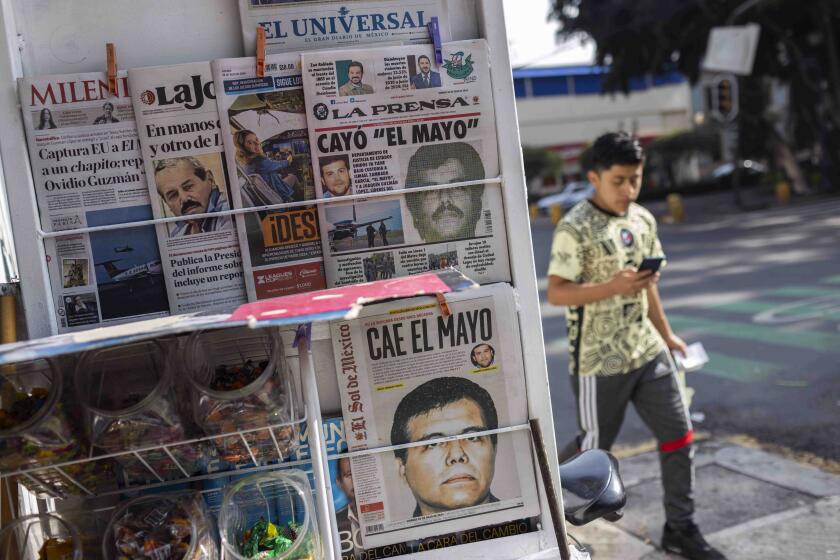Report warned Boston Marathon was vulnerable to terrorism
WASHINGTON — Five days before two bombs tore through crowds at the Boston Marathon, an intelligence report identified the finish line as an “area of increased vulnerability” and warned Boston police that homegrown extremists could use “small-scale bombings” to attack spectators and runners at the event.
The 18-page report, similar to others sent to police and first responders before major events in the Boston area, was written by the Boston Regional Intelligence Center, which is funded in part by the Department of Homeland Security and helps disseminate intelligence information to local police and first responders.
The assessment noted that there was “no credible, specific information indicating an imminent threat” to the race.
FULL COVERAGE: Boston Marathon attack
“The FBI has not identified any specific lone offender or extremist group who pose a threat to the Boston Marathon,” the report said.
In the aftermath of the bombing, who in law enforcement knew what and when have become significant points of contention.
Even as federal officials pointed to the warning as evidence they had done their jobs, Boston and Massachusetts state police officials complained at a congressional hearing Thursday that the FBI had not told them about an earlier investigation involving Tamerlan Tsarnaev, one of two brothers accused of carrying out the April 15 attacks that left three dead and more than 260 injured.
Since the blasts, the FBI has acknowledged that agents interviewed Tsarnaev in 2011 but determined that he did not pose a threat. Customs agents were aware that Tsarnaev, 26, had traveled to Russia in 2012, but decided that he didn’t require additional questioning when he returned to the U.S. later that year.
Boston police officials and members of Congress expressed frustration during the hearing that the FBI and other agencies hadn’t shared more widely what they knew about the Tsarnaevs.
PHOTOS: Boston Marathon bombings
“We would have liked to have known,” Boston Police Commissioner Edward Davis told the House Homeland Security Committee during the first of a series of hearings investigating the attacks. Davis testified that he did not learn about the Tsarnaevs until more than three days after the bombings, after Tamerlan Tsarnaev had been killed in a police shootout and his 19-year-old brother, Dzhokhar, was on the run.
But Davis said he was uncertain what his intelligence officers would have made of Tamerlan Tsarnaev’s 2012 trip to Dagestan, Russia, noting that the FBI had interviewed him but found nothing suspicious and that Russian officials did not tell the FBI why they were interested in him.
“We would certainly have looked at the information,” Davis said. “We would certainly have talked to the individual.” But he added: “I can’t say I would have come to a different conclusion” than the FBI.
Federal officials defended their actions and suggested local law enforcement agencies had not fully followed up on possible threats.
The Tsarnaev brothers’ troubled trail to Boston
The Homeland Security threat assessment was dated April 10 and included a map of the Boylston Street finish line area.
Two officials read parts of it to a Times reporter.
“The possibility exists that [homegrown violent extremists] could attempt an attack by using simple improvised explosive devices or small-arms tactics against easily accessible low-security targets,” said the report by the Boston Regional Intelligence Center, which comprises federal and local law enforcement authorities.
The finish line was the area targeted by the bombers. Both suspects were spotted on surveillance cameras.
Massachusetts authorities dismissed the center’s warning as routine and lacking specifics.
“The assessment about start and finish lines being potential targets was considered and reflected in security plans for the event, as they have been every year,” David Procopio, a spokesman for the Massachusetts State Police, said in a statement. The wording in the report is “standard language” and “based on common sense and accumulated expertise in event security” and not on any specific threat, Procopio said.
“It is akin to saying, in general terms, that airplanes are an attractive target to terrorists,” he said.
PHOTOS: Boston bombing suspects
Richard DesLauriers, special agent in charge of the FBI’s Boston office, said local officials, as members of the Joint Terrorism Task Force there, had access to the information about the brothers, as did the FBI. They all had access to law enforcement’s Guardian Threat Tracking System to review intelligence data, he said.
“Boston [terrorism task force] members, including representatives from the Boston Police Department , were provided instruction on using Guardian, including suggestions on methods for proactively reviewing and establishing customized searches, which would allow them to be fully informed of all [task force] activity that may affect Boston and the Commonwealth of Massachusetts,” DesLauriers said.
He added that in 2011 alone, the Boston task force conducted “approximately 1,000 assessments, including the assessment of Tamerlan Tsarnaev, which was documented in the Guardian database.”
But Rep. Michael McCaul (R-Texas), chairman of the House Homeland Security Committee, said, “The idea that the feds have this information and it’s not shared with the state and locals defies why we created the Homeland Security Department in the first place.”
PHOTOS: Grief, comfort at Boston memorials
The 70 so-called fusion centers like the Boston Regional Intelligence Center were created after the Sept. 11 commission insisted in 2002 that federal, state and local law enforcement agencies needed to cooperate more in counter-terrorism and to analyze potential terrorist activity detected by police.
During a break in the hearing, Police Commissioner Davis was asked about the warning of a possible terrorism incident near the finish line.
He said investigators were conducting a thorough review of all they knew before the bombing and what occurred after.
“A lot has to play itself out yet,” he said. “Everything has to be reviewed.”
More to Read
Sign up for Essential California
The most important California stories and recommendations in your inbox every morning.
You may occasionally receive promotional content from the Los Angeles Times.







